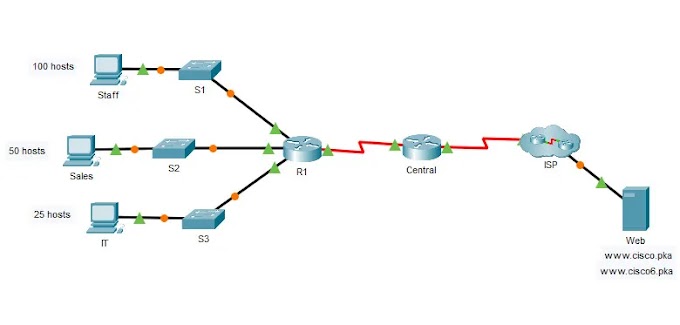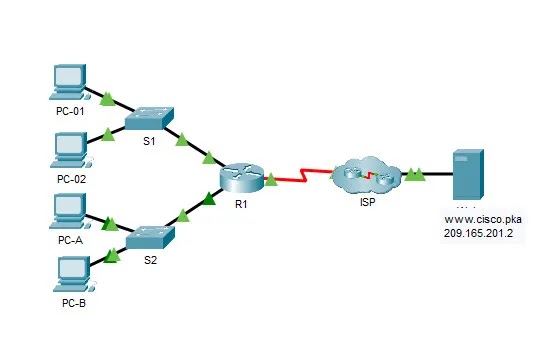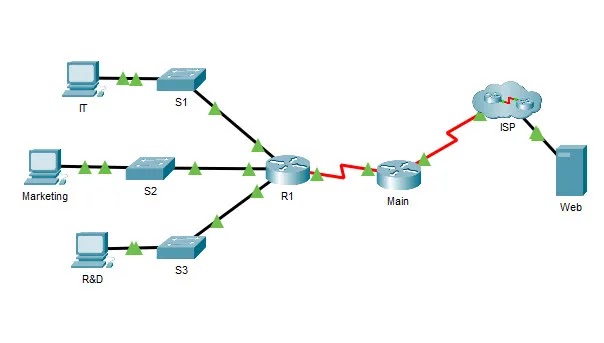[Updated on May, 2021 – 100% Scored]
CCNAv7 Switching, Routing, and Wireless Essentials v7.0 (SRWE) Answers
SRWE PT Practice Skills Assessment (PTSA) Part 1
A few things to keep in mind while completing this activity:
- Do not use the browser Back button or close or reload any exam windows during the exam.
- Do not close Packet Tracer when you are done. It will close automatically.
- Click the Submit Assessment button in the browser window to submit your work.
Introduction
In this assessment you are configuring a network that is using EtherChannel and routing between VLANs. For the sake of time, you will not be asked to perform all configurations on all network devices as you may be required to do in a real network or other assessment. Instead, you will use the skills and knowledge that you have learned in the labs in this course to configure the router and switches in the topology. In addition to EtherChannel and inter-VLAN routing, this task involves creating VLANs and trunks, and performing basic router and switch configuration.
You are required to configure host default gateways; however host addresses are preconfigured.
You will practice and be assessed on the following skills:
- Configuration of initial settings on a router.
- Configuration of initial settings on a switch, including SVI and SSH.
- Configuration of VLANs.
- Configuration of switchport VLAN membership.
- EtherChannel configuration.
- Troubleshooting VLANs.
- Configuration of static trunking and DTP.
- Configuration of routing between VLANs on a Layer 3 switch.
- Configuration of router-on-a-stick inter- VLAN routing on a router.
- Configure default gateways on hosts.
Addressing Table
| Device | Interface | IP Address | Subnet Mask |
|---|---|---|---|
| Edge-Router | G0/0/0 | 192.168.0.1 | 255.255.255. 0 |
| G0/0/1.40 | 192.168.40.1 | 255.255.255.0 | |
| G0/0/1.50 | 192.168.50.1 | 255.255.255.0 | |
| G0/0/1.60 | 192.168.60.1 | 255.255.255.0 | |
| G0/0/1.99 | 192.168.99.17 | 255.255.255.240 | |
| S0/1/0 | 209.165.201.2 | 255.255.255.252 | |
| L3-SW1 | G1/1/1 | 192.168.0.2 | 255.255.255.0 |
| VLAN10 | 192.168.10.1 | 255.255.255.0 | |
| VLAN20 | 192.168.20.1 | 255.255.255.0 | |
| VLAN30 | 192.168.30.1 | 255.255.255.0 | |
| VLAN99 | 192.168.99.2 | 255..255.255.240 | |
| Sw-C | VLAN99 | 192.168.99.18 | 255.255.255.240 |
| WS-1.1 | NIC | 192.168.10.10 | 255.255.255.0 |
| WS-1.2 | NIC | 192.168.20.20 | 255.255.255.0 |
| WS-1.3 | NIC | 192.168.30.30 | 255.255.255.0 |
| WS-1.4 | NIC | 192.168.10.11 | 255.255.255.0 |
| WS-1.5 | NIC | 192.168.20.21 | 255.255.255.0 |
| WS-1.6 | NIC | 192.168.30.31 | 255.255.255.0 |
| WS-2.1 | NIC | 192.168.40.40 | 255.255.255.0 |
| WS-2.2 | NIC | 192.168.50.50 | 255.255.255.0 |
| WS-2.3 | NIC | 192.168.60.60 | 255.255.255.0 |
| Management PC | NIC | 192.168.99.19 | 255.255.255.0 |
| Outside Server | NIC | 203.0.113.100 | 255.255.255.0 |
Background / Scenario
A corporation is planning to implement EtherChannel and a new VLAN design in order to make the network more efficient. You have been asked to work on a design and prototype of the new network. You have created the logical topology and now need to configure the devices in order to evaluate the design. You will configure VLANs and access port VLAN membership on access layer switches. You will also configure EtherChannel and trunking. Finally, you will configure a router and a Layer 3 switch to route between VLANs. Some addressing had already been configured.
Instructions
Part 1: Basic Router Configuration
Step 1: Configure router Edge-Router with required settings.
a. Open a command window on router Edge-Router and move to privileged EXEC mode.
b. Copy and paste the following configuration into the Edge-Router router CLI.
ip route 192.168.10.0 255.255.255.0 GigabitEthernet0/0/0 ip route 192.168.20.0 255.255.255.0 GigabitEthernet0/0/0 ip route 192.168.30.0 255.255.255.0 GigabitEthernet0/0/0 ip route 192.168.99.0 255.255.255.240 GigabitEthernet0/0/0
Be sure to press the <Enter> key after the last line to return to privileged EXEC mode prompt.
c. Configure the following settings on the router:
- The enable secret password.
- A console password
- Remote access to the VTY lines.
- A banner MOTD message.
- The device hostname according to the value in the addressing table.
- All clear text passwords should be encrypted.
- Interface addressing on G0/0/0 and S0/1/0.
- Interface descriptions on G0/0/0 and S0/1/0.
Router(config)#no ip domain lookup Router(config)#enable secret class Router(config)#line console 0 Router(config-line)#password cisco Router(config-line)#login Router(config-line)#exit Router(config)#line vty 0 4 Router(config-line)#password cisco Router(config-line)#login Router(config-line)#exit Router(config)#banner motd #Authorized Access Only!# Router(config)#hostname Edge-Router Edge-Router(config)#service password-encryption Edge-Router(config)#interface g0/0/0 Edge-Router(config-if)#ip address 192.168.0.1 255.255.255.0 Edge-Router(config-if)#no shutdown Edge-Router(config-if)#description Link to Sciences LAN Edge-Router(config-if)#exit Edge-Router(config)#interface s0/1/0 Edge-Router(config-if)#ip address 209.165.201.2 255.255.255.252 Edge-Router(config-if)#no shutdown Edge-Router(config-if)#description Link to Internet Edge-Router(config-if)#exit
Note: Be sure to make a record of the passwords that you create.
Part 2: Basic Switch Configuration
Step 1: Configure Remote Management Addressing
a. Configure SVI 99 on switch Sw-C with IP addressing according to the Addressing Table.
b. The Sw-C switch SVI should be reachable from other networks.
Sw-C(config)#interface vlan 99 Sw-C(config-if)#ip address 192.168.99.18 255.255.255.240 Sw-C(config-if)#no shutdown Sw-C(config-if)#exit Sw-C(config)# Sw-C(config)#ip default-gateway 192.168.99.17
Step 2: Configure Secure Remote Access
On switch Sw-C, configure SSH as follows:
- Username: admin password: C1sco123!
- Modulus bits 1024
- All VTY lines should accept SSH connections only
- Connections should require the previously configured username and password.
- IP domain name: acad.pt
Sw-C(config)#ip domain-name acad.pt Sw-C(config)#crypto key generate rsa How many bits in the modulus [512]: 1024 Sw-C(config)#username admin privilege 15 secret C1sco123! Sw-C(config)#enable secret C1sco123! Sw-C(config)#line vty 0 15 Sw-C(config-line)#transport input ssh Sw-C(config-line)#login local Sw-C(config-line)#exit Sw-C(config)#ip ssh version 2
Part 3: VLAN Configuration
Step 1: Configure VLANs according to the VLAN table.
Use the VLAN Table to create and name the VLANs on the appropriate switches.
VLAN Table
| VLAN | Name | IP Network | Subnet Mask | Devices |
|---|---|---|---|---|
| 10 | FL1 | 192.168.10.0 | 255.255.255.0 | L3-SW1, Sw-A, |
| Sw-B | ||||
| 20 | FL2 | 192.168.20.0 | 255.255.255.0 | L3-SW1, Sw-A, |
| Sw-B | ||||
| 30 | FL3 | 192.168.30.0 | 255.255.255.0 | L3-SW1, Sw-A, |
| Sw-B | ||||
| 40 | FAC | 192.168.40.0 | 255.255.255.0 | Sw-C |
| 50 | BDG5 | 192.168.50.0 | 255.255.255.0 | Sw-C |
| 60 | BDG6 | 192.168.60.0 | 255.255.255.0 | Sw-C |
| 99 | Management | 192.168.99.16 | 255.255.255.240 | Sw-C, L3-SW1 |
L3-SW1
L3-SW1(config)#vlan 10 L3-SW1(config-vlan)#name FL1 L3-SW1(config-vlan)#interface vlan 10 L3-SW1(config-if)#description FL1 L3-SW1(config-if)#ip address 192.168.10.1 255.255.255.0 L3-SW1(config-if)#exit L3-SW1(config)# L3-SW1(config)#vlan 20 L3-SW1(config-vlan)#name FL2 L3-SW1(config-vlan)#interface vlan 20 L3-SW1(config-if)#description FL2 L3-SW1(config-if)#ip address 192.168.20.1 255.255.255.0 L3-SW1(config-if)#exit L3-SW1(config)# L3-SW1(config)#vlan 30 L3-SW1(config-vlan)#name FL3 L3-SW1(config-vlan)#interface vlan 30 L3-SW1(config-if)#description FL3 L3-SW1(config-if)#ip address 192.168.30.1 255.255.255.0 L3-SW1(config-if)#exit L3-SW1(config)# L3-SW1(config)#vlan 99 L3-SW1(config-vlan)#name Management L3-SW1(config-vlan)#interface vlan 99 L3-SW1(config-if)#description Management L3-SW1(config-if)#ip address 192.168.99.2 255.255.255.240 L3-SW1(config-if)#exit
Sw-A
Sw-A(config)#vlan 10 Sw-A(config-vlan)#name FL1 Sw-A(config-vlan)#interface vlan 10 Sw-A(config-if)#description FL1 Sw-A(config-if)#exit Sw-A(config)# Sw-A(config)#vlan 20 Sw-A(config-vlan)#name FL2 Sw-A(config-vlan)#interface vlan 20 Sw-A(config-if)#description FL2 Sw-A(config-if)#exit Sw-A(config)# Sw-A(config)#vlan 30 Sw-A(config-vlan)#name FL3 Sw-A(config-vlan)#interface vlan 30 Sw-A(config-if)#description FL3 Sw-A(config-if)#exit
Sw-B
Sw-B(config)#vlan 10 Sw-B(config-vlan)#name FL1 Sw-B(config-vlan)#interface vlan 10 Sw-B(config-if)#description FL1 Sw-B(config-if)#exit Sw-B(config)# Sw-B(config)#vlan 20 Sw-B(config-vlan)#name FL2 Sw-B(config-vlan)#interface vlan 20 Sw-B(config-if)#description FL2 Sw-B(config-if)#exit Sw-B(config)# Sw-B(config)#vlan 30 Sw-B(config-vlan)#name FL3 Sw-B(config-vlan)#interface vlan 30 Sw-B(config-if)#description FL3 Sw-B(config-if)#exit
Sw-C
Sw-C(config)#vlan 40 Sw-C(config-vlan)#name BDG4 Sw-C(config-vlan)#interface vlan 40 Sw-C(config-if)#ip address 192.168.40.1 255.255.255.0 Sw-C(config-if)#description BDG4 Sw-C(config-if)#exit Sw-C(config)# Sw-C(config)#vlan 50 Sw-C(config-vlan)#name BDG5 Sw-C(config-vlan)#interface vlan 50 Sw-C(config-if)#ip address 192.168.50.1 255.255.255.0 Sw-C(config-if)#description BDG5 Sw-C(config-if)#exit Sw-C(config)# Sw-C(config)#vlan 60 Sw-C(config-vlan)#name BDG6 Sw-C(config-vlan)#interface vlan 60 Sw-C(config-if)#ip address 192.168.60.1 255.255.255.0 Sw-C(config-if)#description BDG6 Sw-C(config-if)#exit Sw-C(config)# Sw-C(config)#vlan 99 Sw-C(config-vlan)#name Management Sw-C(config-vlan)#interface vlan 99 Sw-C(config-if)#ip address 192.168.99.18 255.255.255.240 Sw-C(config-if)#description Management Sw-C(config-if)#exit
Step 2: Assign switch ports to VLANs.
Assign VLAN membership to static access switchports according to the Port to VLAN Assignment table.
Port to VLAN Assignment Table
| Device | VLAN | VLAN Name | Port Assignments |
|---|---|---|---|
| Sw-A | 10 | FL1 | F0/7-10 |
| 20 | FL2 | F0/11-15 | |
| 30 | FL3 | F0/16-24 | |
| Sw-B | 10 | FL1 | F0/7-10 |
| 20 | FL2 | F0/11-15 | |
| 30 | FL3 | F0/16-24 | |
| Sw-C | 40 | FAC | F0/1-5 |
| 50 | BDG5 | F0/6-10 | |
| 60 | BDG6 | F0/11-15 | |
| 99 | Management Native | F0/24 |
Sw-A
Sw-A(config)#interface range f0/7-10 Sw-A(config-if-range)#switchport mode access Sw-A(config-if-range)#switchport access vlan 10 Sw-A(config-if-range)#exit Sw-A(config)#interface range f0/11-15 Sw-A(config-if-range)#switchport mode access Sw-A(config-if-range)#switchport access vlan 20 Sw-A(config-if-range)#exit Sw-A(config)#interface range f0/16-24 Sw-A(config-if-range)#switchport mode access Sw-A(config-if-range)#switchport access vlan 30 Sw-A(config-if-range)#exit
Sw-B
Sw-B(config)#interface range f0/7-10 Sw-B(config-if-range)#switchport mode access Sw-B(config-if-range)#switchport access vlan 10 Sw-B(config-if-range)#exit Sw-B(config)#interface range f0/11-15 Sw-B(config-if-range)#switchport mode access Sw-B(config-if-range)#switchport access vlan 20 Sw-B(config-if-range)#exit Sw-B(config)#interface range f0/16-24 Sw-B(config-if-range)#switchport mode access Sw-B(config-if-range)#switchport access vlan 30 Sw-B(config-if-range)#exit
Sw-C
Sw-C(config)#interface range f0/1-5 Sw-C(config-if-range)#switchport mode access Sw-C(config-if-range)#switchport access vlan 40 Sw-C(config-if-range)#exit Sw-C(config)#interface range f0/6-10 Sw-C(config-if-range)#switchport mode access Sw-C(config-if-range)#switchport access vlan 50 Sw-C(config-if-range)#exit Sw-C(config)#interface range f0/11-15 Sw-C(config-if-range)#switchport mode access Sw-C(config-if-range)#switchport access vlan 60 Sw-C(config-if-range)#exit Sw-C(config)#interface f0/24 Sw-C(config-if)#switchport mode access Sw-C(config-if)#switchport access vlan 99 Sw-C(config-if)#exit
Part 4: EtherChannel and Trunking Configuration
EtherChannel Port Assignments Table
| Channel Group | Devices in Groups | Ports in Group |
|---|---|---|
| 1 | L3-SW1 | G1/0/1, G1/0/2 |
| Sw-A | G0/1, G0/2 | |
| 2 | L3-SW1 | G1/0/3, G1/0/4 |
| Sw-B | G0/1, G0/2 | |
| 3 | Sw-A | F0/5, F0/6 |
| Sw-B | F0/5, F0/6 |
Step 1: Configure EtherChannels
Create EtherChannels according to the EtherChannel Port Assignments Table. Use the Cisco LACP protocol. Both sides of the channel should attempt to negotiate the link protocol.
L3-SW1
L3-SW1(config)#interface range g1/0/1-2 L3-SW1(config-if-range)#channel-group 1 mode active L3-SW1(config-if-range)#exit L3-SW1(config)# L3-SW1(config)#interface range g1/0/3-4 L3-SW1(config-if-range)#channel-group 2 mode active L3-SW1(config-if-range)#exit
Sw-A
Sw-A(config)#interface range g0/1-2 Sw-A(config-if-range)#channel-group 1 mode active Sw-A(config-if-range)#exit Sw-A(config)# Sw-A(config)#interface range f0/5-6 Sw-A(config-if-range)#channel-group 3 mode active Sw-A(config-if-range)#exit
Sw-B
Sw-B(config)#interface range g0/1-2 Sw-B(config-if-range)#channel-group 2 mode active Sw-B(config-if-range)#exit Sw-B(config)# Sw-B(config)#interface range f0/5-6 Sw-B(config-if-range)#channel-group 3 mode active Sw-B(config-if-range)#exit
Step 2: Configure Trunking on the EtherChannels
a. Configure the port channel interfaces as static trunks. Disable DTP negotiation on all trunks.
b. Troubleshoot any issues that prevent the formation of the EtherChannels.
L3-SW1
L3-SW1(config)#interface port-channel 1 L3-SW1(config-if)#switchport mode trunk L3-SW1(config-if)#switchport trunk allowed vlan 10,20,30 L3-SW1(config-if)#exit L3-SW1(config)# L3-SW1(config)#interface port-channel 2 L3-SW1(config-if)#switchport mode trunk L3-SW1(config-if)#switchport trunk allowed vlan 10,20,30 L3-SW1(config-if)#exit
Sw-A
Sw-A(config)#interface port-channel 1 Sw-A(config-if)#switchport mode trunk Sw-A(config-if)#switchport nonegotiate Sw-A(config-if)#exit Sw-A(config)# Sw-A(config)#interface port-channel 3 Sw-A(config-if)#switchport mode trunk Sw-A(config-if)#switchport nonegotiate Sw-A(config-if)#exit
Sw-B
Sw-B(config)#interface port-channel 2 Sw-B(config-if)#switchport mode trunk Sw-B(config-if)#switchport nonegotiate Sw-B(config-if)#exit Sw-B(config)# Sw-B(config)#interface port-channel 3 Sw-B(config-if)#switchport mode trunk Sw-B(config-if)#switchport nonegotiate Sw-B(config-if)#exit
Note: Packet Tracer requires configuration of trunking and DTP mode on both portchannel interfaces and the component physical interfaces.
Step 3: Configure a static trunk uplink
a. On the Sw-C switch, configure the port that is connected to Edge-Router G0/0/0 as a static trunk.
b. Configure the Management VLAN as the native VLAN.
c. Disable DTP on the port.
Sw-C
Sw-C(config)#interface g0/1 Sw-C(config-if)#switchport mode trunk Sw-C(config-if)#switchport nonegotiate Sw-C(config-if)#switchport trunk native vlan 99 Sw-C(config-if)#switchport trunk allowed vlan 40,50,60,99 Sw-C(config-if)#exit
Part 5: Configure Inter-VLAN Routing
Step 1: Configure inter-VLAN routing on the Layer 3 switch.
a. Configure Inter-VLAN routing on the L3-SW1 Layer 3 switch for all VLANs in the VLAN Table that are configured on L3-SW1.
b. Configure the switchport on L3-SW1 that is connected to Edge-Router with an IP address as shown in the Addressing Table.
L3-SW1
L3-SW1(config)#ip routing L3-SW1(config)#interface g1/1/1 L3-SW1(config-if)#no switchport L3-SW1(config-if)#ip address 192.168.0.2 255.255.255.0
Step 2: Configure router-on-a-stick inter-VLAN routing on a router.
a. Configure inter-VLAN routing on Edge-Router for all the VLANs that are configured on the Sw-C switch. Use the information in the Addressing Table.
b. Be sure to configure descriptions of all interfaces.
Edge-Router
Edge-Router(config)#interface g0/0/1 Edge-Router(config-if)#no shutdown Edge-Router(config)#interface g0/0/1.40 Edge-Router(config-subif)#description "Gateway for VLAN40" Edge-Router(config-subif)#encapsulation dot1q 40 Edge-Router(config-subif)#ip address 192.168.40.1 255.255.255.0 Edge-Router(config-subif)#exit Edge-Router(config)#interface g0/0/1.50 Edge-Router(config-subif)#description "Gateway for VLAN50" Edge-Router(config-subif)#encapsulation dot1q 50 Edge-Router(config-subif)#ip address 192.168.50.1 255.255.255.0 Edge-Router(config-subif)#exit Edge-Router(config)#interface g0/0/1.60 Edge-Router(config-subif)#description "Gateway for VLAN60" Edge-Router(config-subif)#encapsulation dot1q 60 Edge-Router(config-subif)#ip address 192.168.60.1 255.255.255.0 Edge-Router(config-subif)#exit Edge-Router(config)#interface g0/0/1.99 Edge-Router(config-subif)#description "Gateway for VLAN99" Edge-Router(config-subif)#encapsulation dot1q 99 native Edge-Router(config-subif)#ip address 192.168.99.17 255.255.255.240 Edge-Router(config-subif)#exit
Step 3: Configure default gateways on hosts.
a. Configure default gateway addresses on all hosts on the LANs.
Default gateway on WS-1.1 and WS-1.4: 192.168.10.1
Default gateway on WS-1.2 and WS-1.5: 192.168.20.1
Default gateway on WS-1.3 and WS-1.6: 192.168.30.1
Default gateway on WS-2.1: 192.168.40.1
Default gateway on WS-2.2: 192.168.50.1
Default gateway on WS-2.3: 192.168.60.1
Default gateway on Management PC: 192.168.99.17
b. Verify connectivity between all hosts on both LANs with each other and the Outside Server server.
c. Verify that a host can connect to the SVI of switch Sw-C over SSH.
Last Updated: January 2021
ID 211
Intructions – Answers

Router Edge-Router
en conf t ip route 192.168.10.0 255.255.255.0 GigabitEthernet0/0/0 ip route 192.168.20.0 255.255.255.0 GigabitEthernet0/0/0 ip route 192.168.30.0 255.255.255.0 GigabitEthernet0/0/0 ip route 192.168.99.0 255.255.255.240 GigabitEthernet0/0/0 no ip domain lookup enable secret class line console 0 password cisco login exit line vty 0 4 password cisco login exit banner motd #Authorized Access Only!# hostname Edge-Router service password-encryption interface g0/0/0 ip address 192.168.0.1 255.255.255.0 no shutdown description "R1 G0/0/0" exit interface s0/1/0 ip address 209.165.201.2 255.255.255.252 no shutdown description "R1 S0/1/0" exit interface g0/0/1 no shutdown interface g0/0/1.40 description "Gateway for VLAN40" encapsulation dot1q 40 ip address 192.168.40.1 255.255.255.0 exit interface g0/0/1.50 description "Gateway for VLAN50" encapsulation dot1q 50 ip address 192.168.50.1 255.255.255.0 exit interface g0/0/1.60 description "Gateway for VLAN60" encapsulation dot1q 60 ip address 192.168.60.1 255.255.255.0 exit interface g0/0/1.99 description "Gateway for VLAN99" encapsulation dot1q 99 native ip address 192.168.99.17 255.255.255.240 end copy running-config startup-config
Switch Sw-C
en config t interface vlan 99 ip address 192.168.99.18 255.255.255.240 no shutdown exit ip default-gateway 192.168.99.17 ip domain-name acad.pt crypto key generate rsa 1024 username admin privilege 15 secret C1sco123! enable secret C1sco123! line vty 0 15 transport input ssh login local exit ip ssh version 2 vlan 40 name BDG4 exit interface vlan 40 ip address 192.168.40.1 255.255.255.0 description BDG4 exit vlan 50 name BDG5 exit interface vlan 50 ip address 192.168.50.1 255.255.255.0 description BDG5 exit vlan 60 name BDG6 exit interface vlan 60 ip address 192.168.60.1 255.255.255.0 description BDG6 exit vlan 99 name Management exit interface vlan 99 ip address 192.168.99.18 255.255.255.240 description Management exit interface range f0/1-5 switchport mode access switchport access vlan 40 exit interface range f0/6-10 switchport mode access switchport access vlan 50 exit interface range f0/11-15 switchport mode access switchport access vlan 60 exit interface f0/24 switchport mode access switchport access vlan 99 exit interface g0/1 switchport mode trunk switchport nonegotiate switchport trunk allowed vlan 40,50,60,99 switchport trunk native vlan 99 end copy running-config startup-config
Switch L3-SW1
en config t vlan 10 name FL1 interface vlan 10 description FL1 ip address 192.168.10.1 255.255.255.0 exit vlan 20 name FL2 interface vlan 20 description FL2 ip address 192.168.20.1 255.255.255.0 exit vlan 30 name FL3 interface vlan 30 description FL3 ip address 192.168.30.1 255.255.255.0 exit vlan 99 name Management interface vlan 99 description Management ip address 192.168.99.2 255.255.255.240 exit ip routing interface g1/1/1 no switchport ip address 192.168.0.2 255.255.255.0 exit interface range g1/0/1-2 channel-group 1 mode active exit interface port-channel 1 switchport mode trunk switchport trunk allowed vlan 10,20,30 exit interface range g1/0/3-4 channel-group 2 mode active exit interface port-channel 2 switchport mode trunk switchport trunk allowed vlan 10,20,30 end copy running-config startup-config
Switch Sw-A
enable config terminal vlan 10 name FL1 interface vlan 10 description FL1 exit vlan 20 name FL2 interface vlan 20 description FL2 exit vlan 30 name FL3 interface vlan 30 description FL3 exit interface range f0/7-10 switchport mode access switchport access vlan 10 exit interface range f0/11-15 switchport mode access switchport access vlan 20 exit interface range f0/16-24 switchport mode access switchport access vlan 30 exit interface range g0/1-2 channel-group 1 mode active exit interface port-channel 1 switchport mode trunk switchport nonegotiate exit interface range f0/5-6 channel-group 3 mode active exit interface port-channel 3 switchport mode trunk switchport nonegotiate end copy running-config startup-config
Switch Sw-B
en config t vlan 10 name FL1 interface vlan 10 description FL1 exit vlan 20 name FL2 interface vlan 20 description FL2 exit vlan 30 name FL3 interface vlan 30 description FL3 exit interface range f0/7-10 switchport mode access switchport access vlan 10 exit interface range f0/11-15 switchport mode access switchport access vlan 20 exit interface range f0/16-24 switchport mode access switchport access vlan 30 exit interface range g0/1-2 channel-group 2 mode active exit interface port-channel 2 switchport mode trunk switchport nonegotiate exit interface range f0/5-6 channel-group 3 mode active exit interface port-channel 3 switchport mode trunk switchport nonegotiate end copy running-config startup-config
Configure default gateway addresses on all hosts on the LANs.
Default gateway on WS-1.1 and WS-1.4: 192.168.10.1
Default gateway on WS-1.2 and WS-1.5: 192.168.20.1
Default gateway on WS-1.3 and WS-1.6: 192.168.30.1
Default gateway on WS-2.1: 192.168.40.1
Default gateway on WS-2.2: 192.168.50.1
Default gateway on WS-2.3: 192.168.60.1
Default gateway on Management PC: 192.168.99.17







